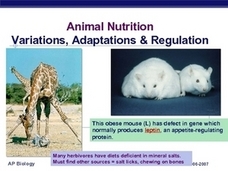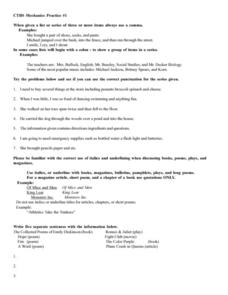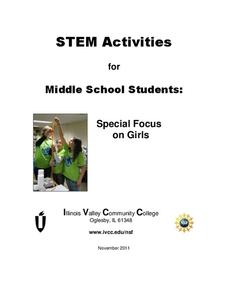Curated OER
Peanut Butter and Jelly: The Importance of Detailed Procedures
Students write a list of steps to be taken in making a peanut butter and jelly sandwich. They observe as the instructor literally follows each step. After realizing the importance of clear communication, students write a scientific...
Curated OER
Find Your Peanut
Sixth graders are given a peanut and is asked to study it carefully. They put their peanuts in a bag and they are mixed up. Students are then asked to find their own peanuts. They make careful observations in order to distinguish between...
Curated OER
Now you see it....Now you Don't
Students investigate the biodegrading process of packing peanuts. In this biological process activity, students conduct an experiment to see how quickly packing peanuts biodegrade. Students check the process each day and record their...
Curated OER
Peanut Butter Broccoli
Students explore selective breeding and genetic engineering. They illustrate that produce items have a wide variety of traits that can potentially be combined to produce a new food by creating a class graph.
Curated OER
Basic Needs of Living Things - Lesson One
An interesting way of teaching about basic needs of different organisms awaits your fourth graders. Pupils take part in class discussions and demonstrations which should lead to a greater understanding of how to determine basic needs. As...
Curated OER
Measurement and Variation
Examine the concept of variation through observation and measurement. Middle schoolers will study a peanut and record any distinguishing characteristics visible as well as sketch their peanuts and describe them in writing. Their peanut...
Curated OER
Your Five Senses
Students identify the five senses. In this biology lesson, students participate in an experiment and use their five senses to identify various substances.
Curated OER
Animal Nutrition - Variations, Adaptations, & Regulation
Colorful pictures and graphics make this a visually-appealing presentation on animal nutrition. Be aware that two of the sixteen slides include blank graphic organizers, so you will need to find the other existing version of this...
Curated OER
Goobers. Goobers? Goobers!
Students begin the lesson by noting the many ways in which to use peanuts. In groups, they use the internet to research the work of George Washington Carver. They discover the allergies and nutritional information of the peanut and...
Curated OER
Energy Content Of Foods And Fuels
High schoolers engage in a study of food and how it used as fuel for the human body. They research how biological systems require energy and compare them to the physical science systems like machines. They compare and contrast what they...
Curated OER
Bioplastics
Students define bioplastics and identify its uses. In this bioplastics lesson plan, students compare and contrast styrofoam to starch peanuts after careful examination. Students understand what biodegradeable means.
Curated OER
Food Chain
Students participate in a simulation of the food chain. In this animal diet instructional activity, the teacher introduces students to the food chain, then assigns each student a part of the food chain to represent. The sun begins...
Curated OER
Basic Needs of Living Things-Lesson One
Fourth graders explore the basic needs of living things. They observe a variety of living things and identify the basic needs of each living item. Students create food balls of peanut butter and nuts to feed animals. They hang their food...
Nuffield Foundation
How Much Energy Is There in Food?
People associate calories with food, but what is a calorie? Young scientists measure the number of calories in samples of food to better understand the concept. They test a variety of samples, take measurements, and compare their results...
Curated OER
Structure and Function of Seeds
Students study the functions of seeds. In this biology lesson plan, students observe the structure of a seed as they show the function of the cotyledons in providing nourishment to the plant during the early times after germination.
Curated OER
Nutrition
Students learn about good nutrition. In this biology lesson plan, students test samples of food to find out if they contain fat, test fruit juices for vitamin C and compare the vitamin C content of the juices, calculate the number of...
Curated OER
Mouthpart Madness
Students explore the basic biology of a pest. They identify the four major kinds of insect mouthparts and explain how they work. Students examine the specific mouthparts and how they can limit food resources and in what environment an...
Curated OER
Insects: Grasshoppers
Students examine grasshoppers as they practice following instructions. In this biology lesson plan, students identify the characteristics of grasshoppers and the functions of grasshoppers' external body parts.
Curated OER
Birds and Birdfeed
Fourth graders examine the basic survival needs of birds before examining a suet ball as an example of what birds eat. They conduct an experiment with pine cones, bird seed, vaseline, and peanut butter. By observing the birds, they...
Curated OER
Animal Nutrition, Variations, Adaptations & Regulation
Information about digestion of various food components is given in this PowerPoint. The diets of herbivores and carnivores are compared, and there are many diagrams giving details of their digestive system specializations. The...
Curated OER
CTBS Mechanics Practice #1
Use this CTBS mechanics activity to reinforce the correct use of commas, punctuation, italics, letter writing, and capitalization. Middle schoolers are given information on each of these areas and then answer a total of thirty multiple...
Illinois Valley Community College
STEM Activities for Middle School Students
Use STEM activities within the class to provide connections to concepts. The resource includes activities that range from working with buoyancy to building rockets and launching them. Other activities involve the engineering design...
Curated OER
Nutrition
Student analyze pictures of food items to determine which of the six food pyramid groups they belong to. They tape the pictures onto a poster of the food pyramid. Upon completing the food pyramid, they draw balance meals on paper plates...
Curated OER
Nothing to Sneeze At
Students explore allergic reactions; they then synthesize their knowledge by creating informational pamphlets that help new allergy patients research the nature of allergies.

























